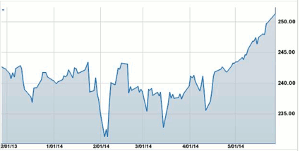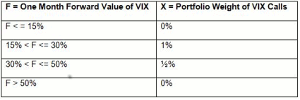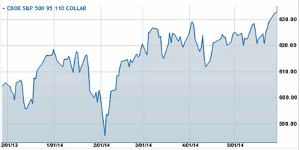Steve Smith of Minyanville.com details three lesser-known S&P 500 and option combinations that benefit from a low-volatility environment.
A host of indices created by CBOE Holdings (CBOE) that employ options strategies are hitting all-time highs this week. It certainly doesn't hurt that the S&P 500 (SPX) and Dow Jones Industrial Average (DJI) are making new record highs themselves.
Thanks to the low-volatility Goldilocks environment created by the steady grind higher, these indices are actually outperforming the benchmark indices through the harvesting of options premium.
The Buy Write Monthly Index (BXM) is a covered call strategy that owns the S&P 500 Index and sells slightly out-of-the money calls with 30 days until expiration. Year-to-date, this index and the ETF based on it, PowerShares S&P 500 BuyWrite Portfolio ETF (PBP) are up 5% compared to 2.5% for the S&P 500. The strategy can be easily replicated using the SPDR S&P 500 ETF Trust (SPY). Variations on this strategy—such as the CBOE S&P 500 Buy Write 2% OTM Index (BXY), which uses further out-of-the-money calls, or the CBOE S&P 500 PutWrite Index (PUTWRT), which sells puts—are also outperforming the S&P 500 so far this year.
Today ,I want to look at three lesser-known S&P 500/option combinations that also benefit from a Goldilocks environment.
Do the Cantango
As I've discussed previously, the normal structure of Volatility S&P 500 (VIX) futures is one of contango—meaning later-dated futures that trade at premium valuations. Given that the futures must ultimately settle with the cash index, there's a natural downward bias as the futures move toward expiration. With the pain of the financial crisis still lingering, investors have had a tendency to overbid for VIX futures in anticipation of future spikes in volatility.
The CBOE Capped VIX Premium Strategy Index (VPD) attempts to take advantage of this pricing structure. It tracks the performance of a strategy that systematically sells one-month VIX futures, capped by the purchase of a VIX call option.
As the futures expire and are rolled forward, the premium is continually captured.
As volatility levels have receded over the past six weeks, the VPD has climbed a respectable 8.2%. The purpose of buying the out-of-the-money call is to protect against a loss should there be a sustained lift in volatility.
Married to Volatility
Many traders are familiar with the concept of a married put, which is the purchase of a put option against a long stock or ETF holding to limit downside risk. The CBOE VIX Tail Hedge Index (VXTH) replaces the put with 30-delta call options on the VIX futures. The VIX calls are purchased monthly.
NEXT PAGE: One More Goldilocks Option Strategy
|pagebreak|The weight of the calls in the portfolio varies at each roll and depends on the forward value of VIX, an indicator for the perceived probability of a major market-moving event. Calculating the weighting can be somewhat complicated. This graphic shows the basic formula:
The power of the VXTH index comes from the exceptionally high returns generated by VIX calls in times of steep stock-market declines. This means few VIX calls need to be purchased. This has the effect of reducing hedging costs and monetizing VIX option profits when extreme volatility levels are reached. This monetization of the VIX option position in turn means that overall capital can be preserved.
Given that volatility tends to spike and retreat quickly, this would be a great strategy for active traders who feel nimble enough to trade out of the VIX call position when volatility jumps. If you just want to use this as a longer-term strategy and leave the heavy lifting of calculating the weighting and rolls to the professionals, I'd suggest using an ETF such as the First Trust Exchange-Traded Fund (VIXH).
Holler for the Collar
A collar entails simultaneously selling calls and buying puts, which has the effect of limiting both gains and downside losses.
The CBOE S&P 500 95-110 Collar Index (CLL) works as follows:
- Holds the stocks in the S&P 500 index;
- Buys three-month S&P 500 put options to protect against market declines; and
- Sells one-month S&P 500 call options to help finance the cost of the put options.
The 95 and 110 in the name refer to the strike prices being used. The puts are about 5% out-of-the-money, and the one-month call options are written at a strike price that's about 10% out-of-the-money. The reason for selling shorter-duration calls than the puts being purchased is to benefit from the acceleration of time decay that occurs as expiration approaches.
This strategy can easily and cheaply be replicated using the SPY, but given the incredibly low-volatility regime we're currently in, I'd tweak this to use calls that are only 5% out-of-the-money and puts that are just 3% out-of-the-money. Note, the CLL was created in late 2008, so the methodology reflects the fact that volatility was hitting historic highs at that time.
The CLL has incurred about 70% of the volatility of the S&P 500 over the last 26 years. This is what its performance over the past six months looks like:
The peak-to-trough descent during January/February was 5.2%, compared to the S&P 500's 6% decline. The collar strategy will provide most of the upside, but more importantly, it limits losses, especially in a sharply declining market.
By Steve Smith, Contributor, Minyanville.com























